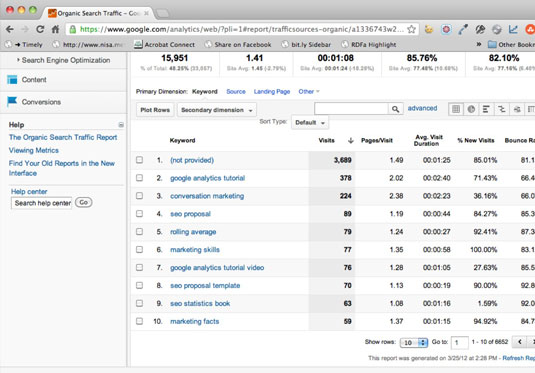In web marketing if you’re getting traffic from search engines (and you’d better be), folks are finding you by searching on keywords. Knowing which keywords they’re using to find you gives you a hint as to the questions they might need to have answered when they first land on your site.
The following holds true for both paid and unpaid keywords.
The following steps walk you through an analysis of referring keywords, using Google Analytics and blog results:
Go to Google and log in. Then click the site profile for which you want to see the report.
Click Traffic Sources in the sidebar on the left and then click Search. Then click Organic or Paid.
The Referring Keyword report that appears will usually look a lot like the referring site report.

Review your keyword report for results that are consistent — and check for anything new or unusual.
Looking at this report, it’s easy to see that Google Analytics Tutorial is a top traffic generator. That’s from a series of posts a long time ago, and it still generates traffic. A quick look at search results on Google shows that the blog is No. 1 and No. 2 for the phrase.
The next few keywords aren’t surprising, except for marketing skills. That’s a tough keyword, and it’s hard to get a respectable ranking for it on any search engine.
To find out the referring sites for a keyword, click it in the results list. On the page that appears, choose Source from the Dimension drop-down list.
The conclusions you can draw from this sleuthing are as follows:
According to a Google search, the blog is near the top of page 1 for that phrase. That explains it.
The page views/visit and time on site aren’t bad, and this is a really tough keyword to keep a top-3 ranking. The task is to write more on the subject to aim at staying on page 1.
One other keyword leaps out: SEO proposal template. It gets 1.28 page views per visit but a meager 19 seconds onsite. That’s awful.
The webpage that keyword sends people to shows a fake proposal template, and folks are probably expecting a real proposal template. Instead, they’re getting a bit of sarcasm. The task is to write a serious proposal template that gets people to stay longer on the site.

